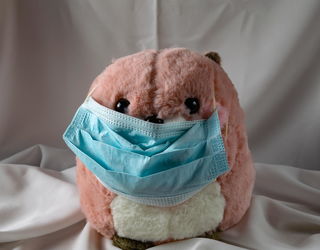Coronavirus Disease 2019
Talking to Kids about Life and Death in the Age of COVID-19
Culture shapes how we talk to children about life and passing during a pandemic.
Posted April 16, 2020

As a mother, there are few things more difficult than exposing your child to reminders of mortality.
Our family had to face the reality of death when my then 9-year-old son was ecstatic to receive his own pet hamster. The animal died that very night. There are many ways to prepare your child for death or loss, but when the opportunity presented itself, I couldn’t bring myself to confront him with the lifeless corpse of his new friend. Instead, I told him Hammy was sick. My husband took Hammy back to the pet store, where he could be “seen by a vet,” and we brought home a brand new Hammy 2.0. The shopkeeper at the pet store was surprised that my husband came back so soon but was understanding when he explained the situation. Apparently, parents returning to replace or resurrect a fallen pet is a relatively common occurrence, and at the time we considered it just another part of parenting. But looking back on this story now, where fear of a deadly pandemic is a looming companion, I wonder if it was truly the most healthy approach for a child. Is death not an inevitable part of life? Should it therefore not be a natural thing to teach your children about it early in life?
COVID-19 is a global event
COVID-19 is the new inescapable global event—a virus contagious enough that it has not only affected those who have fallen ill but has also traumatized those who have witnessed the human destruction it has wrought. Every news station, conversation, and shared endeavor seems to gravitate toward this pandemic, and from this ongoing exposure rises collective angst as people all over the world are confronted with unemployment, isolation, sickness, loss, and death on a much more personal level than this generation has ever seen. By the time this is over, just about everyone will have lost someone they know.
As an at-risk individual, COVID-19 has at times been a source of distress for me personally. I worry that I might struggle for life on a hospital ventilator and suffer a horrible suffocating end while loved ones are scattered far and wide, isolated themselves and unable to be near me in my final hours. However, when discussing these anxieties with family and friends, I am told that I should simply not think about it. Ignore it, move on. I’m being morbid, and talking will do nothing to make the coronavirus any less contagious. I’ll be just fine.
How we cope with death influences how we cope with life
Anxiety around death is a natural human emotion that nearly everyone will experience at some point. Many cultures embrace the concept of death and share it with their children openly from an early age. In Mexican culture, for example, the day of the dead, or Dias De Los Muertos, is an annual celebration and children actively participate (Gutiérrez, Rosengren, and Miller, 2015). Even American culture used to be relatively open about mortality, viewing death as a publicly shared event. This only changed at the beginning of the twentieth century, as parents became more preoccupied with shielding their children from distress (Martinčeková et al., 2020). Whether this is because mortality rates went down and death was no longer a routinely encountered part of everyday life, or for more complex, cultural reasons, it continues to influence how a person copes with death and loss.
“Death phobia concerns far more than the personal anxieties surrounding one’s physical demise and the dying process itself,” notes Dr. Anne Vallely, a University of Ottawa anthropologist who studies death. “It is the worm at the core of our profoundly sick, non-contemplative society. Our dread of aging, obsession with youth, infantilization of the elderly, denigration of nature, and relentless pursuit of productivity all reflect deep-seated anxieties about death, and ultimately amount to inept strategies of denial.”
Avoidance increases fear
From a behavioral perspective, we do feel a pull to avoid that which we fear. And we know that, over time, we tend to exhibit greater fear responses towards that which we continue to avoid. While the effect of early socialization toward death on coping is still unresolved, studies show that open communication about grief and loss related to the death of a loved one leads to a healthier grieving process and an easier time adjusting (Ellis et al., 2013; Field et al., 2014). So, the more we face it, ultimately, the less distress and fear we feel in the long run.
Conversely, it seems a lifetime of avoidance could result in severe terror at journey’s end. Some people try to rob death of this terrorizing influence by taking away the element of surprise. MAiD (medical assistance in dying), now legal throughout Canada, is another cultural phenomenon that demonstrates an institutionalized escape from the anxieties that come with an unknowable but inevitable death. Most assume MAiD is chosen to relieve unbearable physical pain, but the principal reason people chose it is to control the dying process (Nuhn et al., 2018). It can be easier for us to accept death when it is scheduled and ordered into our lives like any other significant event rather than some sudden, unexpected tragedy that upturns us. For the person dying it can be a comforting way to conquer anxieties that would have otherwise followed one to an unforeseeable grave.
Western culture facilitates death avoidance
Our culture colludes quite strongly in death avoidance. The compartmentalization of death as external to everyday life allows us to ignore our own mortality and to fend off bouts of existentialism. One can avoid addressing the thorny concepts of a possible afterlife and ultimate human purpose, thereby allowing ongoing blissful consumerism and a more singular devotion to the deities of work and pursuit of happiness in everyday life.
In therapeutic practice, the topic of death remains a notable taboo. We dive into murky waters with our clients all the time—around childhood abuse, trauma, religion, sex—but when concerns about death arise, we steer the conversation away to safer waters, or perhaps even initiate a suicide assessment. We are too quick to classify talk of death as a symptom of psychopathology rather than something that merits a serious discussion or even just routine therapeutic processing.
Connection over avoidance
Perhaps open communication in these trying times is just what we need right now. Vulnerable communication with others about meaningful things creates new meaningful realities and builds intimacy and connection. Confronting death and related anxieties in this way may help us more than we know. Constant avoidance is what allows death to have such a strong influence over us. Collective ignorance, taught at an early age, was the seed that allowed a deep-rooted fear of such a natural part of life to sprout, its roots nourished by this new threat that grips our hearts and minds.
As we wait for the curve to flatten, consider that avoidance may not be in our interests. Do not be afraid to communicate openly with those who can truly listen. It can be healing when we make space to express our deep fears to each other. It’s time to create an intentional community and conquer uncertainty through direct confrontation and compassion. Do not let death hold on to us with such a tight grip. The sooner we accept it for what it is, the less its specter will haunt our daily lives.
by Monnica Williams, PhD., ABPP, and Naomi Faber
Resources for Authentic Connection
As a clinical psychologist, I know that many people are feeling very alone and isolated at this time. If you are seeking ways to create authentic human connections, I recommend the meet-up group Live with Awareness Courage and Love. There are groups all over the world, and now they are entirely online.
References
Ellis, J., Dowrick, C., & Lloyd-Williams, M. (2013). The long-term impact of early parental death: Lessons from a narrative study. Journal of the Royal Society of Medicine, 106(2), 57-67. doi: 10.1177/0141076812472623
Field, N.P., Tzadikario, R., Pel, D., & Ret, T. (2014). Attachment and mother-child communication in adjustment to the death of a father among Cambodian adolescents. Journal of Loss and Trauma, 19(4), 314-330. doi: 10.1080/15325024.2013.780411
Gutiérrez, I.T., Rosengren, K. S., & Miller, P. J. (2015). Día de los Muertos: Learning about death through observing and pitching in. In M. Correa-Chavez, R. Mejia-Arauz, & B. Rogoff (eds.), Advances in Child Development and Behavior. 49, 229-249). Academic Press.
Martinčeková, L., Jiang, M. J., Adams, J. D., DMenendez, D., Hernandez, I. G., Barber, G., & Rosengren, K. S. (2020) Do you remember being told what happened to grandma? The role of early socialization on later coping with death. Death Studies, 44 (2), 78-88. doi: 10.1080/07481187.2018.1522386
Nuhn, A., Holmes, S., Kelly, M., Just, A., Shaw, J., & Wiebe, E. (2018). Experiences and perspectives of people who pursued medical assistance in dying: Qualitative study in Vancouver, BC. Canadian family physician Medecin de famille canadien, 64(9), e380–e386.
Wallin, A. E., Steineck, G., Nyberg, T., & Kreicbergs, U. (2016). Insufficient communication and anxiety in cancer-bereaved siblings: A nationwide long-term follow-up. Palliative and Supportive Care, 14(5), 488–494. doi: 10.1017/S1478951515001273.




